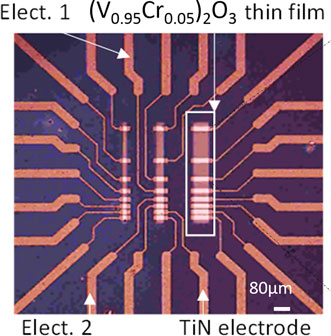Crossref Citations
This article has been cited by the following publications. This list is generated based on data provided by Crossref.
del Valle, Javier
Ramírez, Juan Gabriel
Rozenberg, Marcelo J.
and
Schuller, Ivan K.
2018.
Challenges in materials and devices for resistive-switching-based neuromorphic computing.
Journal of Applied Physics,
Vol. 124,
Issue. 21,
Adda, Coline
Corraze, Benoit
Stoliar, Pablo
Diener, Pascale
Tranchant, Julien
Filatre-Furcate, Agathe
Fourmigué, Marc
Lorcy, Dominique
Besland, Marie-Paule
Janod, Etienne
and
Cario, Laurent
2018.
Mott insulators: A large class of materials for Leaky Integrate and Fire (LIF) artificial neuron.
Journal of Applied Physics,
Vol. 124,
Issue. 15,
Pérez‐Tomás, Amador
2019.
Functional Oxides for Photoneuromorphic Engineering: Toward a Solar Brain.
Advanced Materials Interfaces,
Vol. 6,
Issue. 15,
Rupp, J.A.J.
Janod, E.
Besland, M.-P.
Corraze, B.
Kindsmüller, A.
Querré, M.
Tranchant, J.
Cario, L.
Dittmann, R.
Waser, R.
and
Wouters, D.J.
2020.
Competition between V2O3 phases deposited by one-step reactive sputtering process on polycrystalline conducting electrode.
Thin Solid Films,
Vol. 705,
Issue. ,
p.
138063.
Ronchi, Andrea
Franceschini, Paolo
De Poli, Andrea
Homm, Pía
Fitzpatrick, Ann
Maccherozzi, Francesco
Ferrini, Gabriele
Banfi, Francesco
Dhesi, Sarnjeet S.
Menghini, Mariela
Fabrizio, Michele
Locquet, Jean-Pierre
and
Giannetti, Claudio
2022.
Nanoscale self-organization and metastable non-thermal metallicity in Mott insulators.
Nature Communications,
Vol. 13,
Issue. 1,
Cario, Laurent
Tranchant, Julien
Corraze, Benoit
and
Janod, Etienne
2022.
Metal Oxides for Non-volatile Memory.
p.
307.
Deiana, Allison McCarn
Tran, Nhan
Agar, Joshua
Blott, Michaela
Di Guglielmo, Giuseppe
Duarte, Javier
Harris, Philip
Hauck, Scott
Liu, Mia
Neubauer, Mark S.
Ngadiuba, Jennifer
Ogrenci-Memik, Seda
Pierini, Maurizio
Aarrestad, Thea
Bähr, Steffen
Becker, Jürgen
Berthold, Anne-Sophie
Bonventre, Richard J.
Müller Bravo, Tomás E.
Diefenthaler, Markus
Dong, Zhen
Fritzsche, Nick
Gholami, Amir
Govorkova, Ekaterina
Guo, Dongning
Hazelwood, Kyle J.
Herwig, Christian
Khan, Babar
Kim, Sehoon
Klijnsma, Thomas
Liu, Yaling
Lo, Kin Ho
Nguyen, Tri
Pezzullo, Gianantonio
Rasoulinezhad, Seyedramin
Rivera, Ryan A.
Scholberg, Kate
Selig, Justin
Sen, Sougata
Strukov, Dmitri
Tang, William
Thais, Savannah
Unger, Kai Lukas
Vilalta, Ricardo
von Krosigk, Belina
Wang, Shen
and
Warburton, Thomas K.
2022.
Applications and Techniques for Fast Machine Learning in Science.
Frontiers in Big Data,
Vol. 5,
Issue. ,
Babich, Danylo
Cario, Laurent
Corraze, Benoit
Lorenc, Maciej
Tranchant, Julien
Bertoni, Roman
Cammarata, Marco
Cailleau, Hervé
and
Janod, Etienne
2022.
Artificial Electro-Optical Neuron Integrating Hot Electrons in a Mott Insulator.
Physical Review Applied,
Vol. 17,
Issue. 1,
Adda, Coline
Lee, Min-Han
Kalcheim, Yoav
Salev, Pavel
Rocco, Rodolfo
Vargas, Nicolas M.
Ghazikhanian, Nareg
Li, Chung-Pang
Albright, Grant
Rozenberg, Marcelo
and
Schuller, Ivan K.
2022.
Direct Observation of the Electrically Triggered Insulator-Metal Transition in
V3O5
Far below the Transition Temperature.
Physical Review X,
Vol. 12,
Issue. 1,
Nabil, Amr
Kumar, T. Nandha
and
Almurib, Haider Abbas F.
2022.
Mott Memristors and Neuronal Ion Channels: A Qualitative Analysis.
IEEE Journal on Emerging and Selected Topics in Circuits and Systems,
Vol. 12,
Issue. 4,
p.
762.
Barazani, Eti
Das, Dip
Huang, Chubin
Rakshit, Abhishek
Saguy, Cecile
Salev, Pavel
del Valle, Javier
Toroker, Maytal Caspary
Schuller, Ivan K.
and
Kalcheim, Yoav
2023.
Positive and Negative Pressure Regimes in Anisotropically Strained V2O3 Films.
Advanced Functional Materials,
Vol. 33,
Issue. 31,
Nabil, Amr
Kumar, T Nandha
and
Almurib, Haider Abbas F
2024.
A generic volatile memristor model.
Physica Scripta,
Vol. 99,
Issue. 12,
p.
125031.
Cario, Laurent
Corraze, Benoit
and
Janod, Etienne
2025.
Physics and Chemistry of Chalcogenide Quantum Materials with Lacunar Spinel Structure.
Chemistry of Materials,
Vol. 37,
Issue. 2,
p.
532.
Landsmeer, Lennart Paul Liong
Siddiqi, Muhammad Ali
Abunahla, Heba
Negrello, Mario
Hamdioui, Said
and
Strydis, Christos
2025.
Efficient and Realistic Brain Simulation: A Review and Design Guide for Memristor‐Based Approaches.
Advanced Materials Technologies,
Vol. 10,
Issue. 17,



